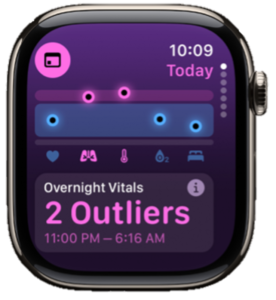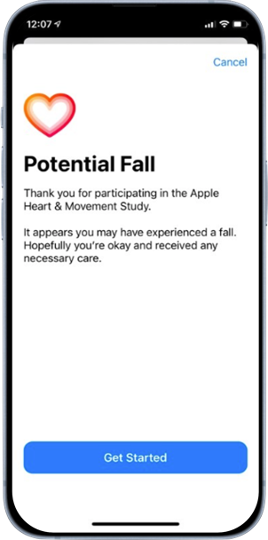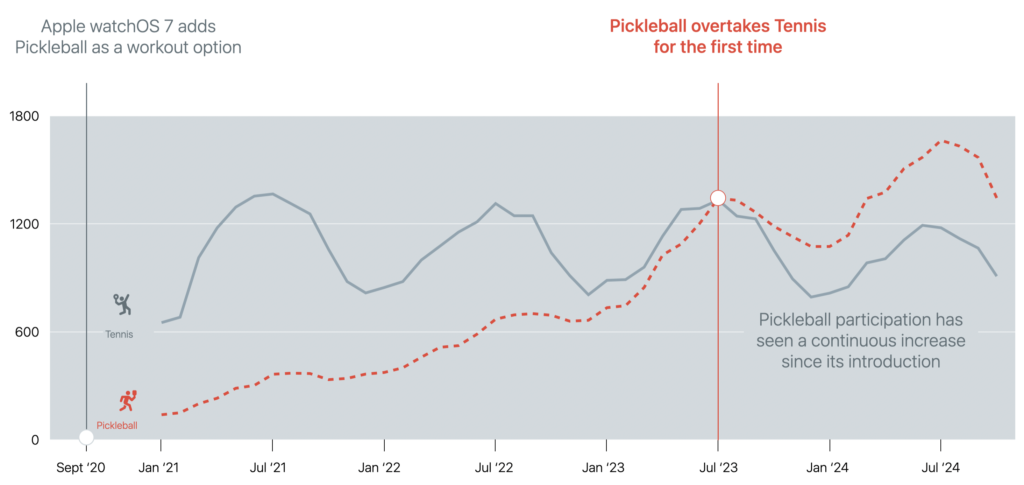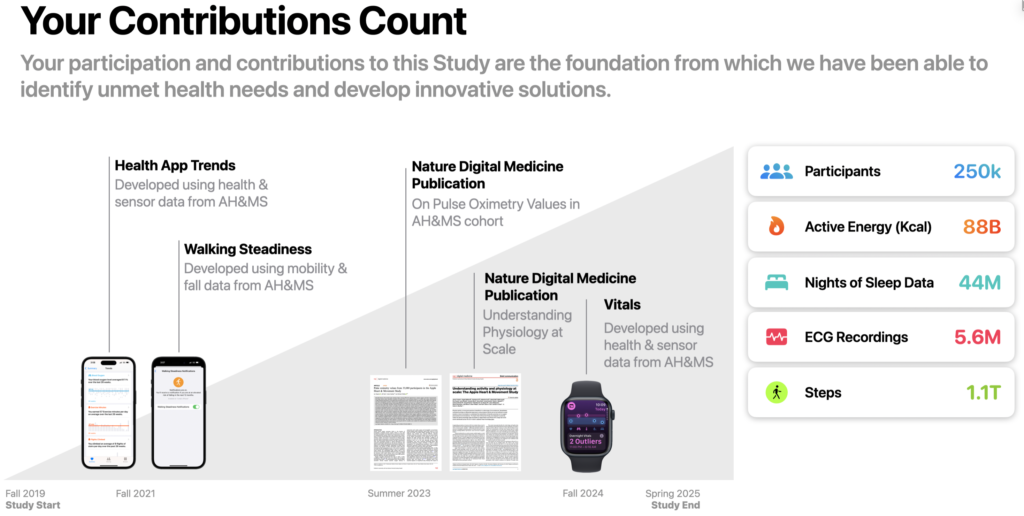
Brigham and Women’s Hospital, the American Heart Association, and Apple come together to celebrate the Apple Heart and Movement Study and its participants.
The start of the new year is a great time to reflect on the incredible impact of the Apple Heart and Movement Study over the last five years. Since November 2019, participant contributions have enabled discoveries in mobility and cardiovascular health, inspired innovations in health features, and expanded accessibility of health research.
At the end of February 2025, data collection for the Apple Heart and Movement Study will close, but the research team will continue to use Study data to further discoveries. Let’s celebrate everyone who has contributed and look ahead to the exciting work to come.
Your Contributions Count
Conducting studies in a diverse and representative participant population allows researchers to answer questions that are inclusive of different voices and histories. It enables scientific discovery and supports the design of innovative features that support the health and well-being of diverse communities.
The design and methods of the Apple Heart and Movement Study have been published in the Journal NPJ – Digital Medicine. 1
By year five of the Apple Heart and Movement Study, we had:
- Enrolled more than 250,000 participants from all 50 states, Washington, D.C., and U.S. territories, representing varied experiences of health.
- A multigenerational participant cohort; ranging from 18 to 90 years of age at the time of enrollment.
- A growing number of female participants, with 38.4% of the study population by year five.
- Data contributions from 15 different models of iPhone and 13 of Apple Watch.
Participants reported their primary motivations for joining the study, including supporting scientific research (77% of participants) and helping to improve technology (61% of participants), with nearly half selecting both. Underscoring the importance of participation in research, Nancy Brown, the Chief Executive Officer of the American Heart Association shares,
“To overcome today’s biggest health challenges, each of us needs to be part of the progress. The Apple Heart and Movement Study shows that technology can help people track their behaviors and health factors, offering invaluable data that deepens our understanding of the connections between physical activity and heart health. On behalf of the American Heart Association, I extend my heartfelt gratitude to all participants who generously shared their data and time to transform lives.”
- Nancy Brown, Chief Executive Officer of the American Heart Association
Progress Towards Study Goals
The Apple Heart and Movement Study was designed to find connections between signals collected daily from Apple Watch and iPhone, and changes in heart health and mobility. Below are some of the many objectives of the Study with updates on the progress researchers have made in these areas:
Understanding how activity and signals measured by apps and sensors on Watch & iPhone relate to current and future health
- In heart health research, sleep has become a top area of interest. Sleep duration and consistency have been linked to a wide range of health topics including brain health, cardiovascular disease, metabolism and quality of life. The American Heart Association added sleep to their Life’s Essential 8 in 2022, which recommends adults get 7-9 hours per sleep on average and includes tips on how to improve your sleep. In our 2022 study update, the Apple Heart and Movement team analyzed 2.9 million sleep nights, shared by participants over a 4-month period (February 1, 2022 – June 1, 2022) identifying on average participants spent 6 hours and 27 minutes sleeping, slightly below the American Heart Association’s recommendation.
“Cardiovascular disease is the leading cause of death both in the U.S. and worldwide. This groundbreaking, data-driven research underscores the importance of Life’s Essential 8 and will empower people of all ages to embrace heart-healthy habits.”
- Eduardo Sanchez M.D., M.P.H., FAHA, Chief Medical Officer for Prevention, American Heart Association
- Apple Heart and Movement Study data gave the research team insight into how blood oxygen saturation varies between daytime and nocturnal hours across a large, healthy population. Data from over 30,000 participants was analyzed across the study cohort to establish trends and significant variation across age, sex, and BMI (body mass index) were reported. The results of this analysis were published in NPJ – Digital Medicine in July 2023.2
- In 2024, Apple introduced the Vitals app to give users a way to quickly view key overnight health metrics, receive alerts when two or more metrics are out of their personalized typical range, and gain better context when it comes to their health. Vitals uses an algorithm developed with data from the Apple Heart and Movement Study to inform out-of-range classifications and notifications, ensuring it is grounded in science and developed with input from clinical experts.

Developing new ways to estimate risk and track changes in mobility, cardiovascular and metabolic disease
- Information that participants in the Apple Heart and Movement Study as well as other studies chose to share with researchers in response to surveys, tasks and data sharing requests helped engineers build Walking Steadiness on iPhone. Data from this feature, along with other mobility-related metrics such as walking speed, step length, and asymmetry will continue to be analyzed and inform research in mobility.
- Research teams at Brigham and Women’s Hospital and Apple are exploring how cardio fitness (or VO2 max), a key indicator of cardiovascular status, changes over time. Initial findings on activity and cardio fitness trends in Apple Heart and Movement Study participants can be reviewed in our updates from 2022 and 2024.
Improving Fall Detection and Mobility Features
- A fall can be a significant event at any age. Prior to this study, falls had not been examined as extensively in younger age groups, and their detection and prevention remained challenging. During the study, participants completed over 370,000 surveys in the Research app and answered 4,600 follow-up calls with Brigham and Women’s Hospital, providing real-world data to improve detection tools and features. We will continue to analyze this data to identify new ways to predict and reduce the risk of falls.

Capturing Unexpected Real-World Trends
Access to Study data in real-time allowed researchers to identify trends as they developed. When COVID-19 shut down many in-person research efforts, the flexibility of our remotely conducted app-based research study allowed us to seamlessly continue data collection and share unexpected insights into how global events and cultural shifts can influence activity.
On a lighter note, in October of 2023, our team reported that the popularity of pickleball surpassed tennis for the first time among the study cohort. As of November 2024, that trend has continued and even grown.

Figure 2: This timeline demonstrates the number of unique participants in the Apple Heart and Movement Study who recorded at least 1 pickleball or at least 1 tennis workout in any given month from January 1st, 2021, to November 1st, 2024. By October 2024, there were 1,344 participants who recorded at least one pickleball workout and 909 for tennis.
Just Scratching the Surface
Every survey answered, data point shared, and phone call completed contributed to a robust dataset spanning over 186 million logged days of health data, allowing researchers to uncover these insights and many more.

Calum MacRae, the Study’s Principal Investigator, shares,
“It is incredible to get the chance to work with such a dedicated community of study participants. We have learned an enormous amount about human health and wellness over the last five years and look forward to continuing to deliver on the original study goals. We are deeply grateful to each and every participant for the data they have contributed and for their continued engagement.”
- Calum MacRae, MD, PhD, Principal Investigator of the Apple Heart and Movement Study, Vice Chair for Scientific Innovation in the Dept. of Medicine at Brigham and Women’s Hospital
Longitudinal studies like the Apple Heart & Movement Study can continue to yield new insights and support discoveries for many years after data collection ends.
What's Next: The Apple Health Study
As data collection for the Apple Heart and Movement Study ends, we invite you to join the holistic Apple Health Study. This new research initiative will further explore how health signals from smart technologies can predict, monitor and improve health and well-being. The Apple Health Study is expanding upon the work in the Apple Heart and Movement Study and includes new areas of health such as hearing, hormones, mental health, metabolic, neurological, reproduction, respiratory health, sex and gender, sleep and more and does not require participants to have an Apple Watch.

You can join the Apple Health Study, if you meet eligibility requirements, by downloading the Apple Research app onto your iPhone and completing the informed consent process.
You can learn more about the Apple Health Study on the Apple Research app.
“Thanks to the contributions from Brigham and Women’s Hospital and the American Heart Association, the Apple Heart and Movement Study helped researchers gain important insights across heart health and mobility. The study’s valuable findings also led to new innovative tools including the Vitals app on Apple Watch and Walking Steadiness on iPhone. We’re thrilled to introduce the Apple Health Study as researchers explore how data can predict, detect, and manage health and wellbeing."
- Sumbul Desai, MD, Vice President of Health at Apple
Thank you for your dedication and commitment over the past five years. Together, we’ve created a foundation for discoveries in heart health and movement. Please consider joining us as we expand the work to focus more broadly on health in the Apple Health Study. Let’s continue building a healthier future, one insight at a time.
1Truslow, J., Spillane, A., Lin, H. et al. Understanding activity and physiology at scale: The Apple Heart & Movement Study. npj Digit. Med. 7, 242 (2024). https://doi.org/10.1038/s41746-024-01187-5
2U.S. Census Bureau, U.S. Department of Commerce. (2023). Age and Sex. American Community Survey, ACS 1-Year Estimates Subject Tables, Table S0101. Retrieved January 28, 2025, from https://data.census.gov/table/ACSST1Y2023.S0101.
3Shapiro, I., Stein, J., MacRae, C. et al. Pulse oximetry values from 33,080 participants in the Apple Heart & Movement Study. npj Digit. Med. 6, 134 (2023). https://doi.org/10.1038/s41746-023-00851-6
